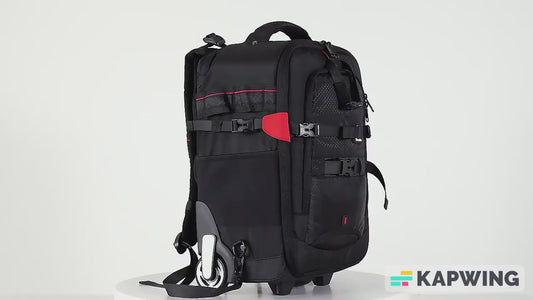Navigating the PERM Process: A Comprehensive Guide for Employers and Foreign Workers
Introduction
In the intricate landscape of U.S. immigration, the path to permanent residency through employment-based green cards is a journey fraught with complexity and challenges. At the heart of this process lies a crucial step known as PERM (Program Electronic Review Management), a labor certification program that plays a pivotal role in the green card application process. For employers seeking to hire foreign talent permanently and for international workers aspiring to build their careers in the United States, understanding PERM is not just beneficial—it's essential.
The PERM process, introduced by the U.S. Department of Labor (DOL) in 2005, serves as a gatekeeper, ensuring that the employment of foreign workers does not adversely affect job opportunities, wages, and working conditions of U.S. workers. As we delve into the intricacies of PERM, we'll explore its significance, current challenges, and strategies for successfully navigating this critical phase of the immigration journey.
Background and Context
Historical Context
The introduction of PERM in 2005 marked a significant milestone in the U.S. immigration system. It replaced the previous labor certification system, which was notorious for its lengthy processing times and paper-based applications. PERM was designed to streamline the process, leveraging technology to create a more efficient and transparent system for labor certification.
Current Relevance and Importance
Today, PERM remains a cornerstone of the employment-based green card process. Its importance cannot be overstated:
- Key Step in Green Card Process: PERM is often the first major hurdle in the employment-based green card journey. Without a certified PERM application, most employers cannot proceed with sponsoring a foreign worker for permanent residency.
- Impact on U.S. Employers: For companies looking to retain top international talent, successfully navigating the PERM process is crucial. It allows them to secure the long-term services of skilled foreign workers in a competitive global market.
- Significance for Foreign Workers: For international professionals, PERM represents a critical step towards achieving their American dream. It's often the beginning of their path to permanent residency in the United States.
What is PERM?
Definition and Purpose
PERM, or Program Electronic Review Management, is a labor certification process administered by the U.S. Department of Labor. Its primary purpose is to ensure that the employment of foreign workers does not adversely affect the job opportunities, wages, and working conditions of U.S. workers.
The core objectives of PERM are:
- To verify that there are no qualified U.S. workers available for the position being offered to the foreign worker.
- To ensure that the wages and working conditions offered to the foreign worker meet or exceed the prevailing standards in the area of intended employment.
Role in the Green Card Application Process
PERM is typically the first step in the employment-based green card process for many categories, including EB-2 (advanced degree professionals and individuals of exceptional ability) and EB-3 (skilled workers, professionals, and other workers).
The successful completion of PERM leads to:
- The ability to file Form I-140 (Immigrant Petition for Alien Worker) with U.S. Citizenship and Immigration Services (USCIS).
- Eventually, the opportunity for the foreign worker to apply for adjustment of status (Form I-485) or consular processing to obtain their green card.
Key Components of the PERM Process
1. Prevailing Wage Determination
The first crucial step in the PERM process is obtaining a Prevailing Wage Determination (PWD) from the DOL. This determination sets the minimum wage that must be offered for the position, ensuring that the employment of a foreign worker doesn't undercut wages for U.S. workers.
Process:
- The employer submits Form ETA-9141 to the DOL's National Prevailing Wage Center (NPWC).
- The NPWC determines the prevailing wage based on factors such as job duties, required education and experience, and geographic location.
Current Status:
As of August 1, 2024, the DOL is processing prevailing wage determinations for requests filed in January 2024 for OES-based determinations and September 2023 for non-OES determinations.
2. Recruitment Process
Once the prevailing wage is determined, employers must conduct a good faith recruitment effort to test the U.S. labor market. This process aims to demonstrate that there are no qualified U.S. workers available for the position.
Key Requirements:
- Posting a job order with the state workforce agency for 30 days
- Placing two Sunday newspaper advertisements
- Conducting three additional recruitment steps from a list of options provided by the DOL
Timeline:
The recruitment process typically spans 60-180 days before filing the PERM application.
3. Filing Form ETA-9089
After completing the recruitment process, if no qualified U.S. workers are found, the employer can file Form ETA-9089, Application for Permanent Employment Certification.
Key Points:
- The form must be filed electronically through the DOL's website.
- It includes detailed information about the job opportunity, the foreign worker's qualifications, and the recruitment process conducted.
- The employer must attest to various statements regarding the job opportunity and the recruitment process.
Current PERM Processing Times and Statistics
Understanding current processing times is crucial for both employers and foreign workers to set realistic expectations and plan accordingly.
Average Processing Times
As of February 2024, the DOL reported the following average processing times:
- 401 days for adjudication of non-audited cases
- 505 days for audit review
These figures represent a significant increase from previous years, reflecting the growing backlog and challenges faced by the DOL in processing PERM applications.
Priority Dates and Estimated Processing Times
The concept of priority dates is crucial in understanding where an application stands in the queue:
- Current Priority Date for Analyst Review: As of May 1, 2024, the DOL was reviewing cases with priority dates of April 2023 or earlier.
- Estimated Processing Time: 387 days (as of May 1, 2024)
This means that applications filed in April 2023 were being reviewed in May 2024, indicating a processing time of approximately 13 months.
Expert Opinions on PERM Processing
The increasing delays and backlogs in PERM processing have not gone unnoticed by immigration experts and practitioners. Their insights provide valuable context to the current state of affairs:
"PERM processing times were eight days longer in February 2024 than in January 2024."
"The average processing time for audit review was 505 days, which is 25 days longer than the previous month."
Immigration attorneys have consistently pointed out that these delays significantly impact both employers' ability to plan their workforce and foreign workers' career trajectories and personal lives.
Case Study: Reddit User Experience
Real-world experiences often provide the most relatable insights into the PERM process. A case shared on Reddit illustrates the typical journey and emotions involved:
A user shared their experience with a PERM application submitted in May 2023. They expressed anxiety and uncertainty due to the long processing times, highlighting the need for H1B extensions to maintain employment status while waiting for PERM approval.
Key takeaways from this case:
- The emotional toll of long waiting periods on applicants
- The necessity of maintaining valid non-immigrant status during the PERM process
- The importance of patience and careful planning in the immigration journey
Current Trends and Future Projections
Increasing Processing Times
The trend of increasing processing times is expected to continue in the near future. Factors contributing to this include:
- Growing number of applications
- Limited resources at the DOL
- Complexity of cases requiring more thorough review
Ongoing Efforts to Clear Backlogs
The DOL has been actively working to manage and reduce backlogs:
- Regular updates to processing times
- Prioritization of certain case types
- Potential technological improvements to streamline the review process
Potential Impact of Broader Immigration Reforms
While no immediate changes to the PERM process itself are anticipated, broader immigration reforms could significantly impact the landscape:
- Potential increases in visa availability could affect demand for PERM
- Changes in labor market testing requirements could alter the recruitment process
- Modernization efforts could lead to more efficient processing systems
Impact Analysis
Challenges for Employers
- Retaining Skilled Foreign Workers: The lengthy PERM process can make it difficult for employers to retain foreign talent, especially when competing with countries that have more streamlined immigration processes.
- Business Operations and Talent Retention: Long processing times can disrupt business planning and talent management strategies. Employers may face uncertainty in long-term project planning and resource allocation.
- Compliance Challenges: The complex and time-sensitive nature of the PERM process puts additional pressure on HR departments to maintain strict compliance with DOL regulations.
Uncertainty for Foreign Workers
- Career Planning Difficulties: The extended waiting periods can hinder foreign workers' ability to make long-term career decisions or pursue advancement opportunities.
- Personal Life Implications: Delays in obtaining permanent residency can affect personal decisions such as buying a home, starting a family, or making long-term commitments in the U.S.
- Visa Status Concerns: Foreign workers may need to maintain and renew temporary visas (e.g., H-1B) while waiting for PERM approval, adding additional layers of complexity and potential stress.
Comparison with Alternative Visa Categories
To provide context, it's useful to compare PERM with other popular visa categories:
| Visa Category | Processing Time | Eligibility | Purpose |
|---|---|---|---|
| PERM (leading to EB-2/EB-3) | 387-505 days | Job offer requiring labor certification | Permanent residency |
| H-1B | Typically 1-6 months | Specialized knowledge positions | Temporary work ( up to 6 years) |
| L-1 | Typically 1-6 months | Intra-company transferees | Temporary work (up to 5-7 years) |
| O-1 | Typically 1-6 months | Individuals with extraordinary ability | Temporary work (initial 3 years) |
Key differences:
- PERM leads to permanent residency, while others are temporary
- PERM requires extensive labor market testing, unlike other categories
- Processing times for PERM are significantly longer than for temporary visas
Controversies and Debates
The PERM process has been subject to ongoing debates within the immigration community:
Fairness and Efficiency of the PERM Process
- Processing Times: Many argue that the current processing times are unreasonably long, causing undue hardship for both employers and foreign workers.
- Complexity: The intricate requirements of the PERM process, particularly in recruitment, have been criticized as overly burdensome and potentially disconnected from real-world hiring practices.
- Audit Selection Criteria: There are ongoing discussions about the fairness and transparency of the DOL's audit selection process.
Impact on U.S. Job Market and Foreign Workers
- Protection of U.S. Workers: Proponents argue that PERM is crucial for protecting job opportunities for U.S. workers, while critics contend that it may hinder U.S. companies' ability to compete globally.
- Skills Gap: There's debate about whether PERM adequately addresses the skills gap in certain industries, particularly in STEM fields.
- Brain Drain Concerns: Some argue that lengthy and uncertain PERM processes may discourage highly skilled foreign workers from seeking employment in the U.S., potentially leading to a "brain drain" to other countries with more favorable immigration policies.
How To: Navigating the PERM Process
Preparing for PERM Filing
-
Assessing Eligibility and Timing:
- Evaluate the foreign worker's qualifications against the job requirements
- Consider the employee's current visa status and expiration dates
- Assess the company's ability to meet PERM requirements, including recruitment and wage obligations
-
Gathering Required Documentation:
- Compile detailed job descriptions and minimum requirements
- Collect evidence of the foreign worker's qualifications (degrees, experience letters)
- Prepare organizational documents (tax returns, business licenses) if needed for potential audits
Strategies for Efficient PERM Processing
-
Thorough Preparation of Form ETA-9089:
- Ensure all information is accurate and consistent with recruitment efforts
- Double-check for common errors that could lead to denials or audits
- Consider using immigration software or professional services to minimize errors
-
Proactive Communication with DOL:
- Stay informed about current processing times and priority dates
- Promptly respond to any requests for additional information
- Consider reaching out to the DOL for status updates if processing times exceed published averages
Handling Potential Audits
-
Preparing for Audit Requests:
- Maintain meticulous records of all recruitment efforts
- Keep detailed documentation of the foreign worker's qualifications
- Be prepared to explain any complex or unique aspects of the job requirements
-
Responding to Audit Queries Effectively:
- Respond promptly and comprehensively to all DOL requests
- Provide clear explanations for any potential issues or discrepancies
- Consider seeking legal counsel for complex audit responses
Alternatives to Consider While Waiting for PERM Approval
-
Maintaining Valid Nonimmigrant Status:
- Ensure timely extension or renewal of current visas (e.g., H-1B, L-1)
- Explore options for changing to a different nonimmigrant status if necessary
-
Exploring Other Visa Options:
- Consider alternative employment-based visa categories (e.g., O-1 for individuals with extraordinary ability)
- Evaluate eligibility for other green card categories that may not require PERM (e.g., EB-1 or National Interest Waiver)
FAQ Section
Q1: How does the PERM process affect an employee's current visa status?
A1: The PERM process itself does not directly affect an employee's current visa status. However, due to the lengthy processing times, employees often need to maintain and renew their nonimmigrant status (e.g., H-1B) while the PERM application is pending. It's crucial to ensure continuous lawful status throughout the process. Learn more about maintaining status on the USCIS website.
Q2: What happens if a PERM application is denied?
A2: If a PERM application is denied, the employer has several options:
- File a request for reconsideration with the DOL within 30 days of the denial.
- File an appeal with the Board of Alien Labor Certification Appeals (BALCA) within 30 days.
- Start the PERM process again with a new application.
The choice depends on the reason for denial and the specific circumstances of the case. For more information, visit the DOL's PERM website.
Q3: Can an employee change jobs during the PERM process?
A3: The PERM process is employer-specific. If an employee changes jobs before the PERM is approved, the new employer would need to start a new PERM process. However, after I-140 approval (the next step after PERM), there may be options for job portability under certain conditions. Refer to INA Section 204(j) for more details on job portability.
Q4: Are there any expedited processing options for PERM?
A4: Currently, the DOL does not offer premium or expedited processing for PERM applications. All applications are processed in the order they are received, with some exceptions for emergency situations or cases of national interest. Check the DOL's PERM processing times for the most up-to-date information.
Q5: How does PERM relate to the overall green card process?
A5: PERM is typically the first step in the employment-based green card process for EB-2 and EB-3 categories. After PERM approval, the process continues with:
- Filing Form I-140 (Immigrant Petition for Alien Worker) with USCIS
- Filing Form I-485 (Adjustment of Status) or pursuing consular processing, depending on the employee's location and preference
The entire process from PERM to green card can take several years, depending on various factors including country of birth and visa availability. For more information on the green card process, visit the USCIS Green Card page.
Challenges and Solutions
Managing Long Processing Times
Challenge: Uncertainty and potential status issues due to extended waiting periods.
Solution:
- Strategic planning: Start the PERM process well in advance of visa expirations.
- Maintain valid nonimmigrant status: Ensure timely extensions or renewals of current visas.
- Explore alternative visa options: Consider other temporary visa categories that may provide more flexibility.
Navigating Complex Recruitment Requirements
Challenge: Meeting DOL standards while finding qualified U.S. workers in a competitive job market.
Solution:
- Thorough understanding of DOL requirements: Familiarize yourself with all PERM recruitment requirements and best practices.
- Professional assistance: Consider engaging immigration attorneys or specialized recruitment firms to ensure compliance and effectiveness.
- Tailored recruitment strategies: Develop industry-specific recruitment plans that meet DOL standards while effectively reaching potential U.S. candidates.
Handling Audits and Requests for Evidence
Challenge: Responding effectively to DOL inquiries and providing comprehensive documentation.
Solution:
- Proactive documentation: Maintain detailed records of all recruitment efforts, applicant evaluations, and decision-making processes.
- Legal consultation: Seek advice from experienced immigration attorneys when preparing audit responses.
- Timely and thorough responses: Address all DOL queries comprehensively and within specified deadlines.
Ethical Considerations and Best Practices
Ensuring Fair Recruitment Practices
- Genuine job opportunities: Ensure that all PERM applications are for bona fide job openings that accurately reflect the company's needs.
- Unbiased evaluation: Assess all applicants, including U.S. workers, based on objective criteria related to the job requirements.
- Transparent job postings: Provide clear, accurate job descriptions and requirements in all recruitment materials.
Balancing Employer Needs with U.S. Worker Protections
- Good faith recruitment: Conduct thorough and genuine efforts to recruit U.S. workers, even when sponsoring a foreign worker.
- Fair wage determination: Ensure that the offered wage meets or exceeds the prevailing wage for the position and location.
- Ongoing compliance: Regularly review and update hiring practices to align with both business needs and DOL requirements.
Transparent Communication with Foreign Workers
- Clear expectations: Provide foreign workers with realistic timelines and potential challenges in the PERM process.
- Regular updates: Keep sponsored employees informed about the status of their PERM application and any relevant developments.
- Support and resources: Offer access to legal resources or counseling to help foreign workers navigate the emotional and practical aspects of the process.
Success Stories and Testimonials
Reddit User's PERM Approval Experience
"Filed in November 2022, approved in October 2023. It's a long road, but stay patient and keep your documentation organized. Here are some lessons I learned:
- Start early: Begin the process well before your current visa expires.
- Stay informed: Regularly check processing times and priority dates.
- Be prepared for audits: Keep meticulous records of all recruitment efforts.
- Communicate with your employer ": Maintain open lines of communication about the process and any concerns."
My advice for others: Stay positive, be patient, and don't hesitate to seek professional help if needed. The process can be stressful, but it's manageable with the right approach and support."
This success story highlights the importance of preparation, patience, and thorough documentation throughout the PERM process.
Tools, Equipment, and Resources
DOL's Online Systems for Filing and Tracking
-
PERM Online System: The primary platform for submitting and managing PERM applications.
- Features: Electronic filing, case status updates, and communication with DOL.
- Access: https://www.plc.doleta.gov/
-
FLAG System: Foreign Labor Application Gateway for prevailing wage determinations.
- Features: Submit and track prevailing wage requests.
- Access: https://flag.dol.gov/
Crowdsourced Trackers
-
PERMtimeline.com: A community-driven platform for tracking PERM processing times.
- Features: Real-time updates from applicants, statistical analysis of processing trends.
- Benefits: Provides more granular and up-to-date information than official sources.
-
Trackitt: Online forum and visa application tracker.
- Features: User-reported timelines for various immigration processes, including PERM.
- Benefits: Offers insights into real-world experiences and processing trends.
Legal Resources and Immigration Attorney Services
-
American Immigration Lawyers Association (AILA):
- Resource: Provides updates on immigration law and policy, attorney directory.
- Website: https://www.aila.org/
-
DOL's Office of Foreign Labor Certification (OFLC) Website:
- Resource: Official source for PERM regulations, processing times, and updates.
- Website: https://www.dol.gov/agencies/eta/foreign-labor
-
Immigration Law Firms:
- Resource: Specialized legal services for PERM and employment-based immigration.
- Benefits: Expert guidance, case management, and representation in complex cases.
Conclusion
Navigating the PERM process in the current immigration landscape requires patience, diligence, and strategic planning. As we've explored throughout this comprehensive guide, the path to permanent residency through employment-based green cards is fraught with challenges, from extended processing times to complex regulatory requirements.
Key takeaways:
- Understand the process: A thorough understanding of PERM requirements and timelines is crucial for both employers and foreign workers.
- Plan strategically: Start the PERM process well in advance, considering current processing times and potential delays.
- Maintain compliance: Adhere strictly to DOL regulations, particularly in recruitment and wage determination.
- Stay informed: Keep abreast of the latest updates in processing times, priority dates, and potential policy changes.
- Seek professional assistance: Consider engaging immigration attorneys or specialized services to navigate complex cases and audits.
The future of PERM and employment-based immigration remains uncertain, with potential reforms on the horizon. However, the fundamental role of PERM in balancing the needs of U.S. employers with the protection of U.S. workers is likely to persist.
For employers, the PERM process represents both a challenge and an opportunity to secure vital talent in a global marketplace. For foreign workers, it's a critical step towards achieving their American dream. By staying informed, prepared, and adaptable, both parties can navigate this complex process more effectively.
As the immigration landscape continues to evolve, the importance of expert guidance, thorough preparation, and ethical practices cannot be overstated. Whether you're an employer looking to sponsor foreign talent or a skilled worker seeking permanent residency, approaching the PERM process with diligence and informed strategy will be key to your success.
Additional Resources
-
DOL's PERM Website:
- Official resource for PERM regulations, forms, and updates.
- Link: https://www.dol.gov/agencies/eta/foreign-labor/programs/permanent
-
Immigration Law Blogs and Forums:
- ImmigrationGirl: Insights and updates on immigration law.
Link: https://www.immigrationgirl.com/ - Visa Journey: Community forum for immigration discussions.
Link: https://www.visajourney.com/
- ImmigrationGirl: Insights and updates on immigration law.
-
Professional Associations for Immigration Attorneys:
- American Immigration Lawyers Association (AILA)
Link: https://www.aila.org/ - National Association of Immigration Lawyers
Link: https://www.immigrationlawyers.org/
- American Immigration Lawyers Association (AILA)
-
USCIS Resources:
- Official site for immigration forms and information.
- Link: https://www.uscis.gov/
-
Department of State - Visa Bulletin:
- Monthly update on visa number availability.
- Link: https://travel.state.gov/content/travel/en/legal/visa-law0/visa-bulletin.html
-
Immigration Policy Center:
- Research and analysis on U.S. immigration policy.
- Link: https://www.americanimmigrationcouncil.org/
These resources provide valuable information, updates, and community support for those navigating the complex world of U.S. immigration and the PERM process. Remember to cross-reference information and consult with qualified legal professionals for personalized advice on your specific situation.





































































